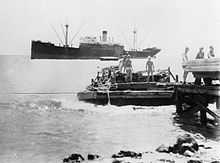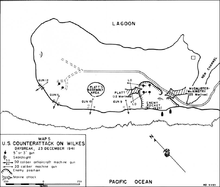Wilkes Island





Wilkes Island is a small islet that is part of the Wake Island, a remote atoll in the Pacific. The island is cut in half by a partially completed WW2 submarine channel, and the eastern half is connected to Wake Island by a causeway. The western half is mostly trees and nature, except for mowed grassy area for seabirds, while the eastern half has facilities for the Wake island base. On the north side of Wilkes is the shallow lagoon of the atoll, and across to the north side is Peale Island and the northern hook of the main Wake island. The south side of Wilkes is coral beach with rocky coral fragments; the waves crash on the coral reef the rings the atoll, a short distance from the southern shore of Wilkes.
Overview[edit]
Wilkes is on the south and west side of the Wake: The western and bit north tip of Wilkes is called Kuku Point, in the middle running north-south is the unfinished submarine channel, and on the south end there is a causeway that crosses Wilkes Channel to the main island.[1]
The Tanager Expedition set up a tent camp on Wilkes in the 1923, when they surveyed Wake Island. Wake was difficult to land on so the ship stayed in deep water just off from the island, and the expedition was brought ashore by a smaller boat.[2][3] Wake is difficult to land on, as its ringed on all sides by a coral reef and there was no harbor, the only break is Wilkes channel between Wake and Wilkes.[4][5]
Wilkes Island was named during the Tanager Expedition for the U.S. Naval officer Charles Wilkes, who led a U.S. expedition to Wake Atoll in 1841.[6][7]
In the 1930s, it was the site where supplies were off-loaded for the Pan-Am airways seaplane facilities, which was built on Peale Island on the other side of the Wake Lagoon. Supplies were offloaded at Wilkes, moved across a short rail to the other side, then taken by barge across the lagoon to Peale.[8]
It was the location of some of the fighting during the Battle of Wake Island in December 1941. Wilkes was the site of a shore battery and defenses, as part of the overall defenses of Wake island, when WW2 broke out. Japanese troops landed on the Wilkes island as part of the invasion of island, which fell 23 December 1941.[9]
On 10 December 1941, a group of Japanese G3M Nell bombers struck Wilkes island killing one marine and detonating 120 tons (US tons) of dynamite, that was stored on the island for construction of the military base.[10]
In the 21st century, Wilkes island is home to a bird sanctuary with at least 12 species of nesting seabird, and up to tens of thousands of birds.[11]
Weather[edit]
Summary of the weather at Wilkes, the same as for Wake Island overall:[12] [13]
| ||||||||||||||||||||||||||||||||||||||||||||||||||||||||||||||||||||||||||||||||||||||||||||||||||||||||||||||||||||||||||||
References[edit]
- ^ "HyperWar: A Magnificent Fight: Marines in the Battle for Wake Island". www.ibiblio.org. Retrieved 2023-12-01.
- ^ Wetmore, Alexander (1923). Album 1 Pacific Islands, 1923 (Tanager Expedition), volume 2. [s.n.]
- ^ Wetmore, Alexander (1923). Album 1 Pacific Islands, 1923 (Tanager Expedition), volume 2. Smithsonian Institution Archives.
- ^ "Pan American". Bonita Gilbert. 2012-12-14. Retrieved 2023-12-01.
- ^ "HyperWar: The Defense of Wake [Appendix VII]". www.ibiblio.org. Retrieved 2023-12-01.
- ^ History and Ornithological Journals of the Tanager Expedition of 1923 to the Northwestern Hawaiian Islands, Johnston and Wake Islands, Storrs L. Olson, National Museum of Natural History, Smithsonian Institution, Washington, DC, February 1996
- ^ "Education Resources: Regional Information, Wake Island | PacIOOS". Pacific Islands Ocean Observing System (PacIOOS). Archived from the original on 2023-11-01. Retrieved 2023-12-01.
- ^ "Pan American". Bonita Gilbert. 2012-12-14. Archived from the original on 2023-06-07. Retrieved 2023-12-01.
- ^ "A Magnificent Fight: Marines in the Battle for Wake Island (Introduction)". www.nps.gov. Archived from the original on 2023-11-03. Retrieved 2023-12-01.
- ^ "A Magnificent Fight: Marines in the Battle for Wake Island (Introduction)". www.nps.gov. Archived from the original on 2023-11-03. Retrieved 2023-12-01.
- ^ "11th AF Det. 1 Wake Island". www.15wing.af.mil. Archived from the original on 2023-10-16. Retrieved 2023-12-01.
- ^ a b "NASA Earth Observations Data Set Index". NASA. Retrieved 30 January 2016.
- ^ "NASA Earth Observations: Rainfall (1 month - TRMM)". NASA/Tropical Rainfall Monitoring Mission. Retrieved 30 January 2016.

